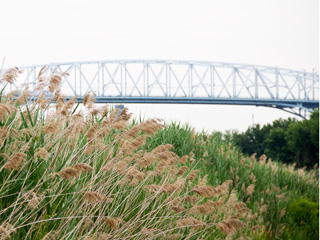 story by Bernard Brown | photo by Lucas HardisonIn europe, they simply call it the common reed, but over here we can’t dignify the villain with such an innocuous name, especially when its scientific name, Phragmites, sounds so sinister: “frag-MITE-ees,” pronounced with a grimace.
story by Bernard Brown | photo by Lucas HardisonIn europe, they simply call it the common reed, but over here we can’t dignify the villain with such an innocuous name, especially when its scientific name, Phragmites, sounds so sinister: “frag-MITE-ees,” pronounced with a grimace.
“Who’s afraid of a big bad reed?” you might ask. They’re not spiny like Devil’s Walking Stick or savagely thorny multiflora rose; they don’t give you a rash like poison ivy (a native). The feathery-topped reeds won’t hurt you, and they make for beautiful landscapes, bending in the breeze in elegant, rippling waves.
Unfortunately, something innocuous at home can become a terribly invasive weed in a new location where it has no pests and unprepared competition. This is what Phragmites has done in wetlands in our region, and through much of the eastern United States.
Think of the view below the Girard Point Bridge. Along the confluence of the Schuylkill and the Delaware, you see some industrial ports and crawling ships, of course, but the banks are carpeted with those acres of uniform, uninterrupted reeds. It looks kind of pretty until you realize there is nothing there BUT reeds… Phragmites.
“It’s a nightmare,” says Gary Stolz, John Heinz National Wildlife Refuge manager, the gloriously enormous freshwater tidal marsh right next to the airport. “It becomes a monoculture that’s sterile for wildlife.” Our native freshwater tidal marsh is much more varied and hospitable: a mix of heart-leaved spatterdock, grassy wild rice, clumps of sedges, cattails, and even our own meek reeds (a native Phragmites species that’s been overwhelmed by the invader). Our native critters generally don’t eat Phragmites (why it’s so successful), and get crowded out along with the plant communities they’ve evolved to inhabit. Goodbye minks; goodbye beavers.
No one is quite sure how Phragmites got to the United States, but without the native creatures that feed on it (something like 170 species of European fauna have it on their menu), it hooked its tenacious rhizomes into the Atlantic coast of North America and spread west. The pernicious reed generally has not overpowered our native flora all on its own; we have helped it along. Phragmites does best where we have disturbed wetland soils and removed the competition; for example, by dumping fill or building roads and canals.
Once established, it is nearly impossible to eradicate. Alternatives range from excavating the reed beds (though ripping out the marsh sort of defeats the purpose) to smothering with thick black plastic sheeting for three consecutive years to repeated mowing for two years—often impossible in soggy wetlands. Burning actually encourages growth, and we have yet to confirm European Phragmites pests that will work on our soil, but won’t endanger our own native plants.
The best option for saving our native plants is the seemingly incongruous practice of spraying pesticides. The herbicide glyphosate is specifically approved by the EPA for wetland use in its formulation as Rodeo (as opposed to Roundup), and is the weapon of choice for those who do battle with the Phrag. Phragmites tend to grow later into the fall than our native wetland plants, so the glyphosate, which breaks down quickly in the environment, can be used late in the season with little risk to our then-dormant natives.
The U.S. Fish and Wildlife Service has waged a nearly decade-long battle against Phragmites at Heinz, attacking it “mechanically and chemically, removing it year after year,” mowing it where and when they could. It’s hard enough to spray and pull weeds on solid land; try it in thigh-deep mud. You’d bring in the helicopters, too.
The Refuge has won back almost 100 acres from the Phragmites, Stolz says, replanting them with native wetland flora. Nine years in, “we’re seeing species showing up we haven’t seen in ages.”
Bernard Brown is an amateur field herper, part-time bureaucrat and director of the PB&J Campaign (pbjcampaign.org), a movement focused on the benefits of eating lower on the food chain. Read about his forays into the natural world at phillyherping.blogspot.com. Pick up next month’s issue to squish into the Delaware river mud with freshwater mussels.
Fight invasive weeds with the Friends of Heinz Refuge’s Weed Warriors. To learn more, visit friendsofheinzrefuge.org then scroll to the bottom of the page for the info.


